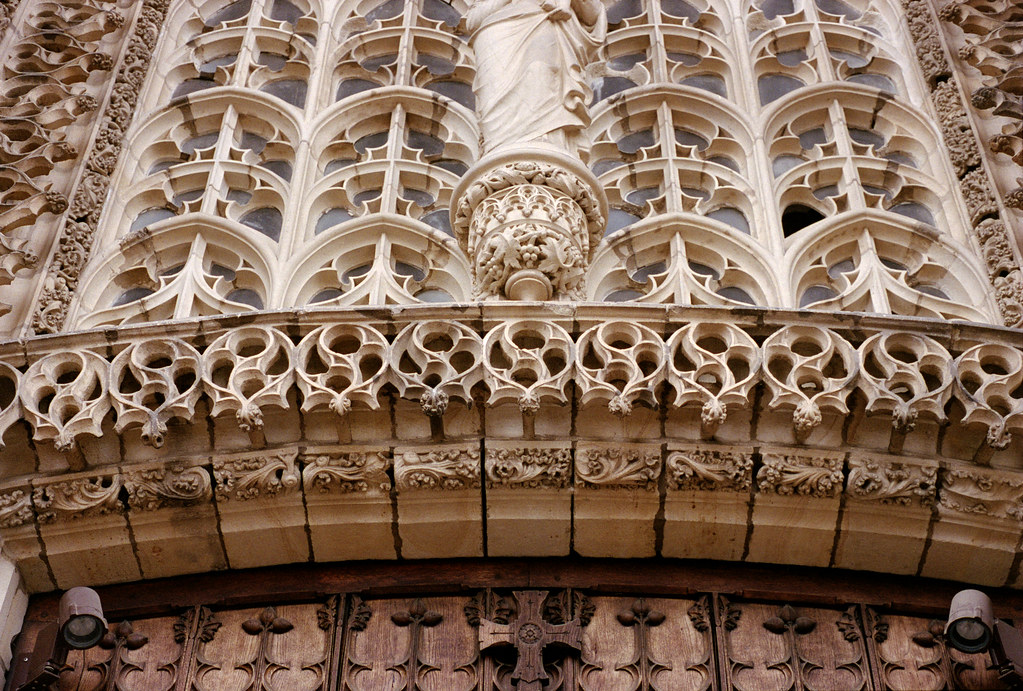#50mm f/1.8 AI-s
Explore tagged Tumblr posts
Video
T. rex by Rogier van Oostrom Via Flickr: Nikon FA | Nikkor 50mm f/1.8 AI-s | Ilford Delta 3200 EI1200 Home developed in Ilford DD-X 1+4, 9min30sec@20C Scanned with Plustek Opticfilm 8200i Converted and further processing using Negative Lab Pro
#Plustek Opticfilm 8200i#35mm#Film#Negative Lab Pro#Ilford Delta 3200#Ilford DD-X#50mm f/1.8 AI-s#Nikon FA#1+4#Home Scan#bw#blackandwhite#flickr
0 notes
Video
Exterior detail of the Basilique Cathédrale Sainte-Cécile d'Albi, Albi France - 2022.06.27 by r~ Via Flickr: Nikon FM2n Nikkor 50mm f/1.8 ai-s pancake Kodak Portra 400 2022083-24
#Nikon#FM#Nikon FM2n#Analog#France#35mm film#135#C41#Kodak Portra 400#slr#vintage Camera#Europe#Color negative#color film#Travel Photography#Prime Lens#Manual Focus#Albi#Nikkor 50mm f/1.8 ai-s pancake lens#flickr
0 notes
Text
I’ve been asked to explain my kit and my workflow by @savage-daughter-of-nikitie.
I use either a Canon 80D, Canon 5D Mk IV or a Sony A7Riv with a sigma MC-11 mount converter. I also have a Canon 300D and a Canon 70D from both of which I have removed the internal infrared filter, so that I can shoot in the Infrared.
I have a number of tripods and LED light panels which I sometimes use, but for most general things I prefer to use natural light with perhaps a small reflector.
Lens-wise, my aviation photography is done using either a Sigma 60-600mm f/4.5-6.3 OS DG Sports or a Canon 100-400mm f/4.5-5.6L MkI.
For other general photography such as landscapes and when I do portraits, (which I don’t post here). I have a range of lenses but my favourites are:
* Canon EF 24-70mm f/2.8l USM
* Canon 50mm f/1.8
* Lensbaby Velvet 56mm f/1.6
* Canon EF-S 10-22mm f/3.5-4.5 (this won’t fit on the Sony / MC-11 combo)
For macro photography I generally use either a Sigma 105mm f/2.8 EX DG OS HSM macro or, very occasionally, a Canon MP-E 65mm 1-5x Macro with a lot of light and a macro rail.
I occasionally use a Newer variable ND e.g to slow flowing water and I have various intervalometers, and all of the Pluto Trigger and Dripper kit for water droplets or complex triggering.
I also use my phone camera more and more and then achieve effects in Lightroom, Photoshop or Topaz AI
My workflow varies depending upon the type of photography. By way of an example, for the flower studies my workflow is:
1. Photos were taken on a variety of kit, mainly my phone.
2. Import into Lightroom
3. Square crop the flower and rotate to get the best light/symmetry/arrangement.
4. Use Lightroom’s Subject Mask to initially mask the flower and refine using brush addition/subtraction
5. Duplicate and invert the mask to effectively mask the background
6. Set exposure, contrast, highlights, shadows, whites, blacks and saturation to zero. This removes the background allowing the flower to stand alone but gives me the option to recover the background should I wish to later.
7. At this point any issues with masking become very noticeable so I will often refine both flower and background masks once more.
8. Return to the flower mask and set the exposure, contrast, white balance, response curves, saturation and sharpness as required, to make the flower pop.
9. I often apply radial masks to even the exposure or highlight the inner or outer sections at this point.
10. Use the heal tools to remove pollen specs, imperfections or other issues. Lightroom’s content aware AI healing is extremely good these days.
11. I then catalogue, add metadata, and export to a number of private and public storage and distribution services.
I have two projects I want to start as we move into winter, life permitting.
Firstly, I want to try to do some star trails. Near where I live there is a park on an escarpment running east west, with a couple of stone crosses that can be photographed from the south with the Polaris (the North Star, which is the centre or rotation in the night sky) just above the top of one of them.
I also want to play more with my 70D and do some more IR photography. This makes warmer parts of the scene brighter and cooler darker and can lead to some eerie effects. I have a long standing desire to visit a certain chateau in France and photograph it in IR.
This is probably way more than you were asking for and I’m not sure is this is what you wanted to know, but I hope it helps.
14 notes
·
View notes
Note
I keep making these huge reblog posts and deleting them cuz they're too long. Anyway, I shoot digital and 35mm film. I currently use a Nikon D5600 DSLR with a bunch of lenses, too many really, a Nikkor 18-300mm f/3.5-6.3G ED VR (does almost everything), a Tokina atx-i 11-20mm f/2.8 CF (wide angle and fast), a Nikkor 35mm f/1.8 (fast prime, good in low light), and a Micro-Nikkor 40mm f/2.8 (macro, for really close) lens. They are all great (and expensive 😭). You don't need this for digital unless you want to do everything, and this is just a mid-range DX body. I often wish I had just gotten a Fujifilm X100V or a Sony RX100 Mk VII. For film I use a Lomo LC-A pocket camera that I bought 20 years ago. I love the photos, even the mistakes. The newer model (LC-A+) appears to be better. I also use a Nikon FM2 SLR with a Nikkor 50mm f/1.8 Ai-S lens. Love them too. I can give advice on where to get info, where to buy, what to watch out for, but that would take too long. Just ask me if you want to know. If you just want to try it out, ask an older relative if they have a 35mm film camera, or an old digital with a good battery, in their closet that they'll give you. Hope that helps.
Hey! Could you recommend a camera for someone who is hoping to get into photography but not for anything too serious, I guess just as a hobby!?
I love your blog & photos btw. 💕
I recommend the camera I use - the Canon AE-1 Program! The body is fairly inexpensive and there are tons of compatible lenses. It’s easy to shoot manually because of the built in light meter, but you can also use the program mode if you want everything automatic.
I know next to nothing about digital so if any digital photographers have recommendations, the floor is yours.
7 notes
·
View notes
Photo
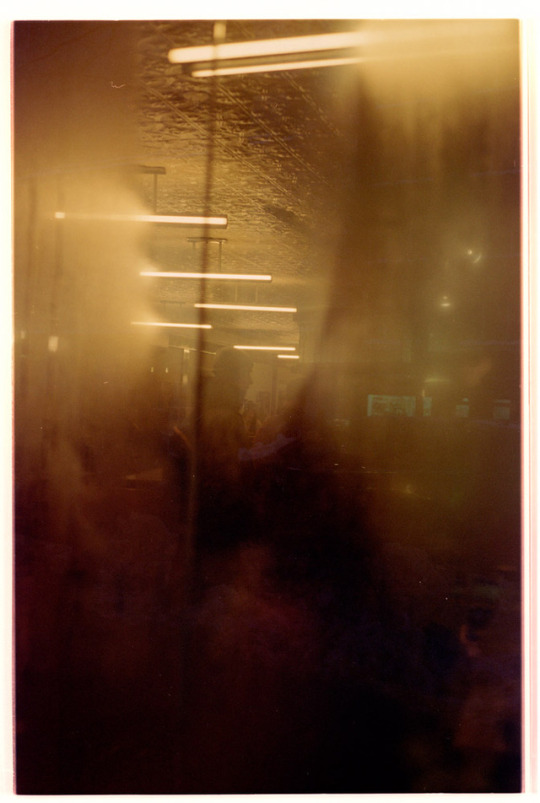
Nikon F100 | Ai-S Nikkor 50mm f/1.8 | Kodak Gold 200
#50mm f/1.8#Film#Kodak#Kodak Gold 200#Nikkor#Nikon#Nikon F100#Sean Klingelhoefer#Visual Journal#ai-s nikkor#film photography#film scans#i shoot film#new york city#visual diary#original photographers#photographers on tumblr#artists on tumblr#art photo#daily photo#street photo#tumblr photographers#lights from above#third eye
210 notes
·
View notes
Text
バイトその2
le vendredi 15 février / 2019年2月15日(金曜日)
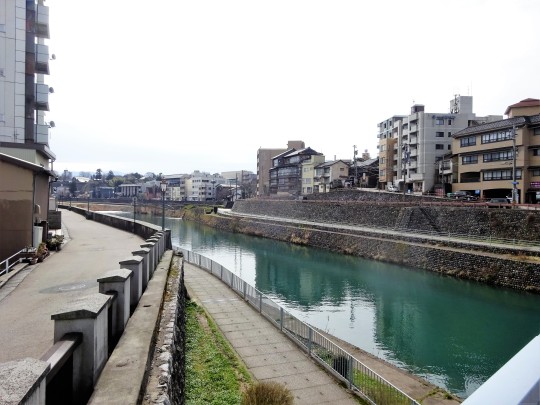
きょうは研究協力のために大学へ。今,研究室にいます。朝,現像されたフィルムが届いていたので早速見てみました。後ほど載せますね。
間も無く先生が来て,実験室に案内してくれました。眼筋の測定。以外に集中力が必要でした。単調な実験だからと,先生がYouTubeで洋楽をかけてくれました。Shape of Youとか,Maroon 5のSugarとか,Countn’ starsとか。スタンダードナンバー(?)
数十分後,
「どんな曲が好きなの?洋楽?邦楽?声入ってるやつ?」
「ん~,リクエストしても良いですか。」
「良いよ。」
というわけで早速。
ベートーヴェン 交響曲第9番(カラヤン指揮,ベルリンフィル)を。
「カラヤンのってありますか?」
「ああ,丁度カラヤンのが出たよ。ベルリンフィル...去年解禁されたんだね。1968年の録音...50年前か..」
全楽章を鑑賞しました。圧巻です。いつもは通学のBGMとして聞いてはいますが,鑑賞したのはOEKによる生演奏以来。
続いて,
シューマン ピアノ協奏曲イ短調(アバド指揮,P:ポリーニ)
先生「色々あるよ。ツィマーマン,マルタ・アルゲリッチ,アンドリュー・フォン・オーエン,クラウディオ・アバド / マウリツィオ・ポリーニ...ポリーニ有名だよねえ。」
わざわざスピーカーを接続して再生してくれていました。
音楽もそうですけれど,良い体験が出来ました。眼の周りに電極を貼り付けたりして,楽しかったです。写真撮ってもらえば良かった...。
あと,時々広告が入ってくるのが楽しかったです。ローソンの「ちょい乗り自動車保険」。動画がYouTubeの公式チャンネルに上がっていました。しかも,今日アップロードされたばかり。
BGMの合間に何度も聴いたので耳に残っちゃいました。楽しいCMではありませんか。最初はラジオか何かかな?と思ったのですが,広告だったのですね。古めかしい意匠で制作されていて,音だけ聞いているとラジオ感があります。
帰りは学内の郵便局へ行って,フィルムの現像料の振り込みを済ませました。
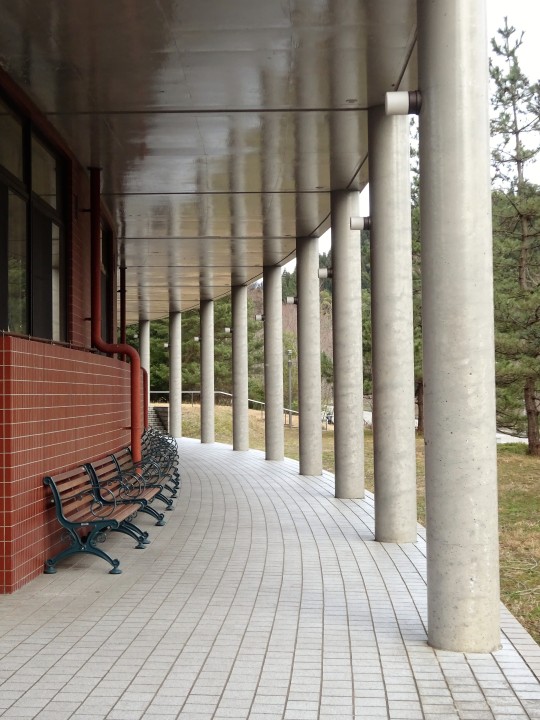
大学会館で,オケがパート練習をしているのを目撃。大きな弦楽器やフルートなどきらびやかでした。

カモを一羽だけ観測できました。貯水池みたいな所に群れで泳いでいるのです。以前撮影した写真がこちら。
カシャッ!
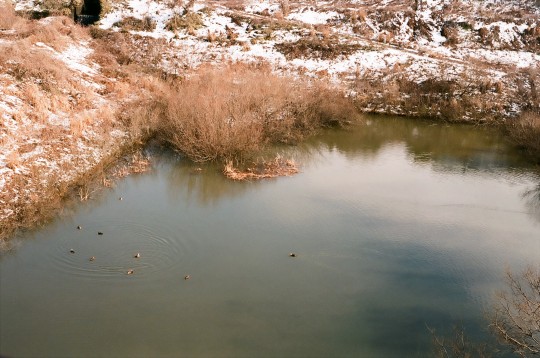
今朝届いたばかりの銀塩写真です。
バスで帰ります。
カフェには行けず。また来週にでも行きましょう。
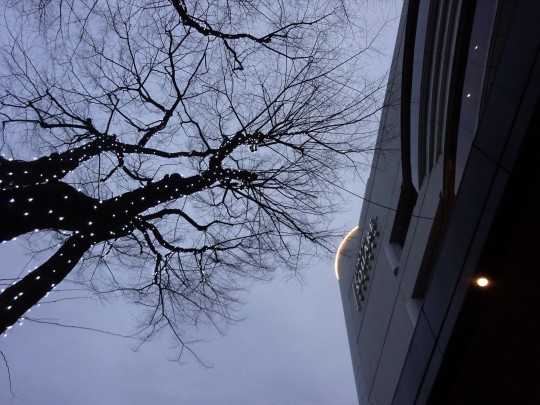
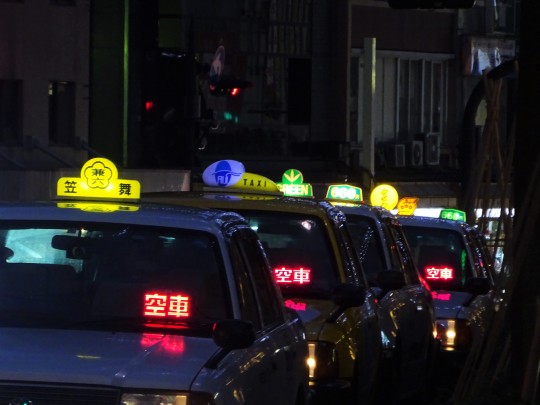
段々とライトが目立つようになってきます。
駅から家まで,ガクッと落ち込みましたがそれ以外はとっても健康でした。
明日もこの調子でレポートを頑張りましょう。
ではお約束どおり,フィルム写真をご覧に入れます。待たせたわりには全然大したこと無いのですけれど。
フィルムもカメラもレンズもいつも通り。
ASA100の業務用フィルム(135-24) / ニコンFM / AI NIKKOR 50mm F1.8 S
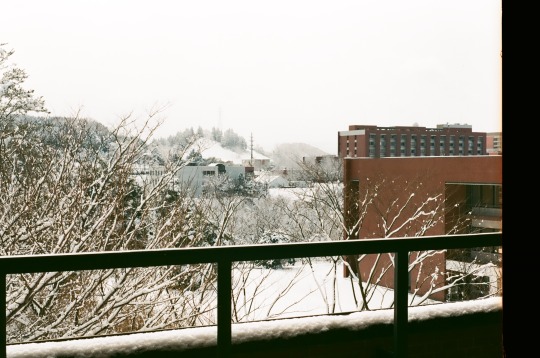
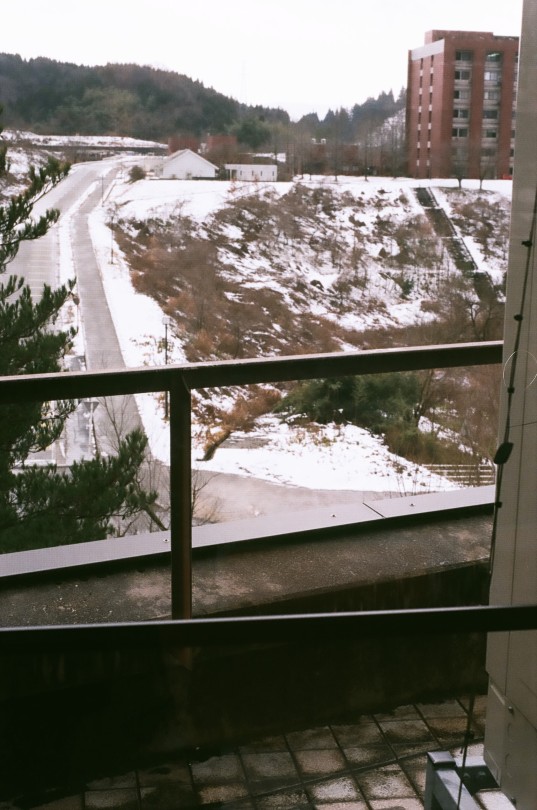
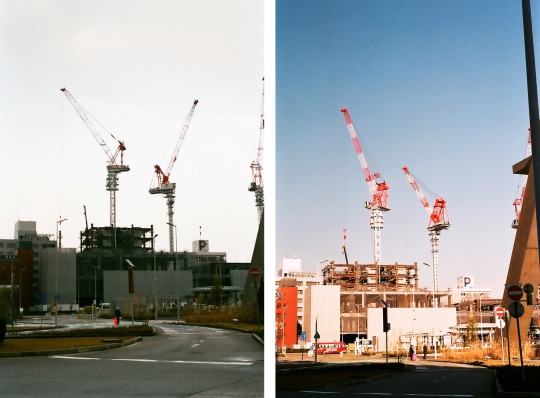
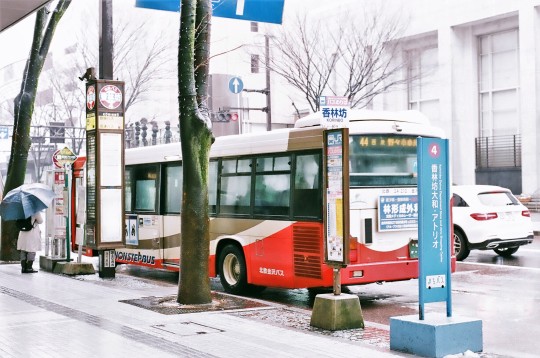
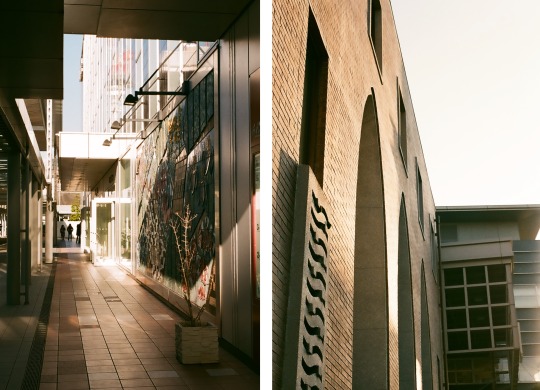
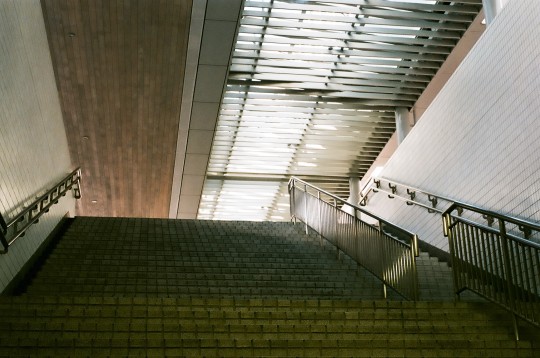
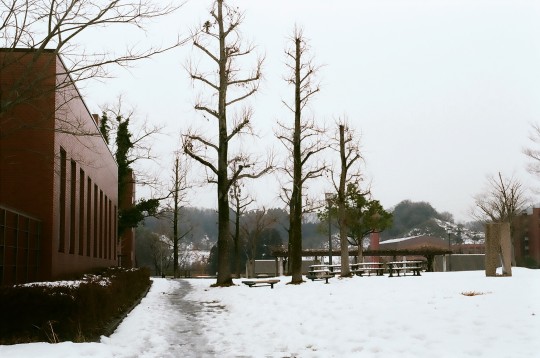
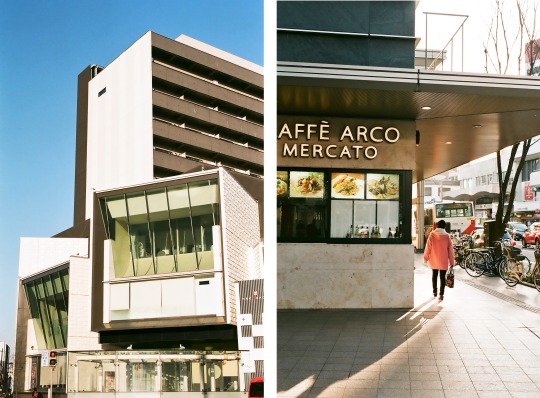
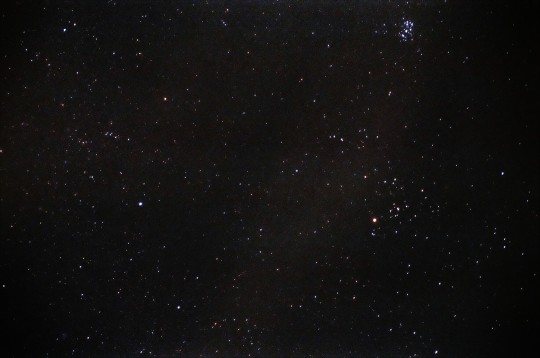
綺麗でしょ!弟をバス停まで迎えにいった時に撮ったのです。三脚を持ってこなかったので車の屋根にカメラを固定して,50mmのレンズでF値を1.8⇒2.8にし,シャッターを30秒間 開けっぱなしにしました。
気軽に撮った天体写真ですけど,今までで一番うまく撮れたし撮っているときも楽しかったです。やはり気軽に撮れるのが性に合っているようです。三脚を立ててフードを付けてレリーズを付けて...と重装備だと失敗が許され��い気がして..。
冬は空が澄んでいるのでまたチャレンジしたいです。
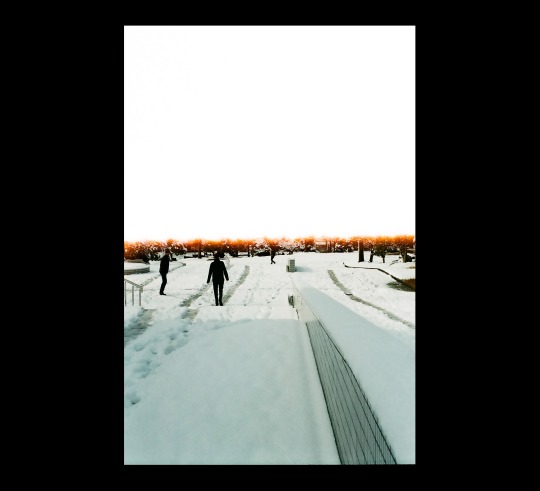
ゼロ枚目。フィルムの最初の一コマには不思議な愛着を覚えます。感光していて写っていない範囲があるのが他の24枚とは違うので。いつか0枚目だけ集めて写真展に飾ってあげたいです。
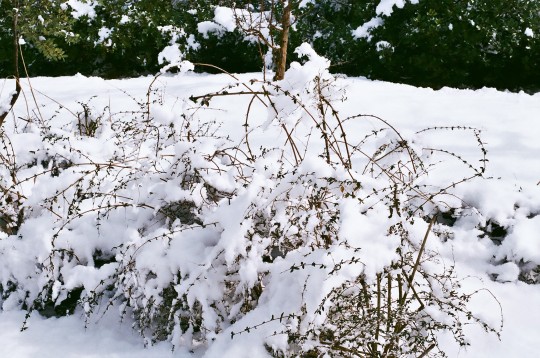
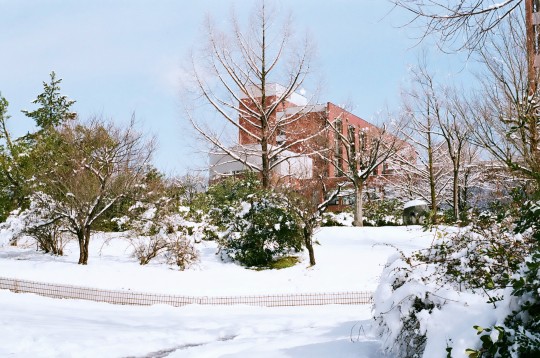
雪が積もった日,嬉しくて何枚も撮っていました。晴れていると雪が輝いて見えて美しいです。
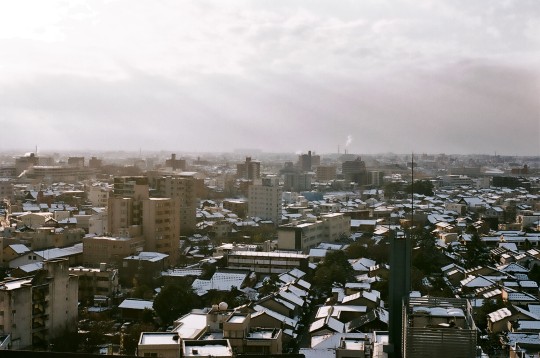
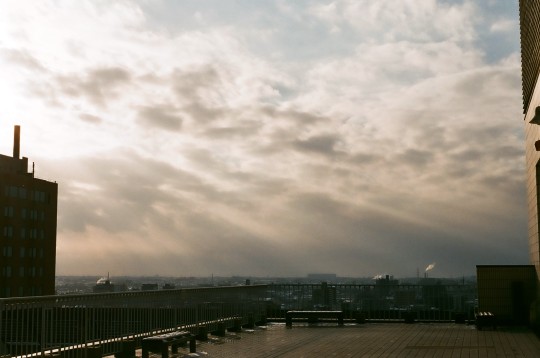
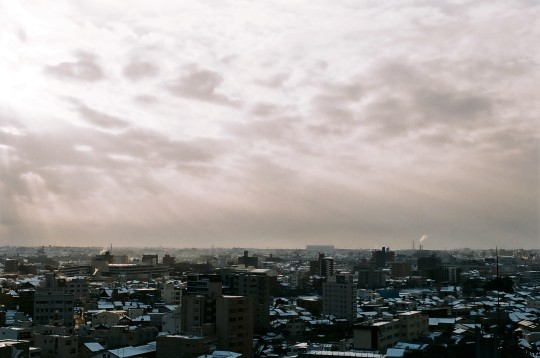
デパートの屋上に昇った時のものですね。色々なアングルを試していたのでした。
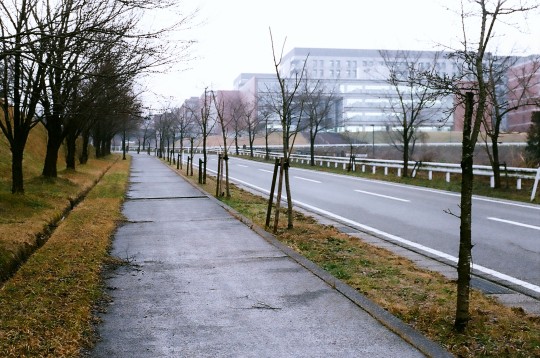
いつもとは別の道を通ってカウンセリングに行った時。
夏には青々とした並木になって,壮観です。いつか友達をポートレートしようと思います。
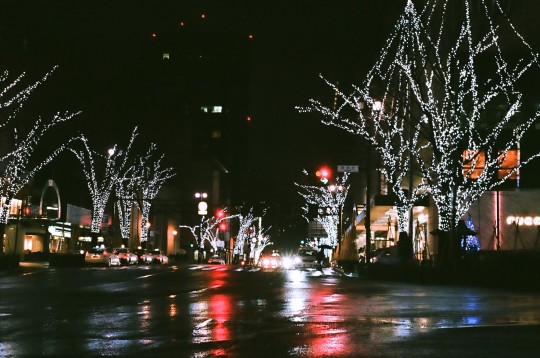
香林坊で夜景を撮るときの定番スポット。
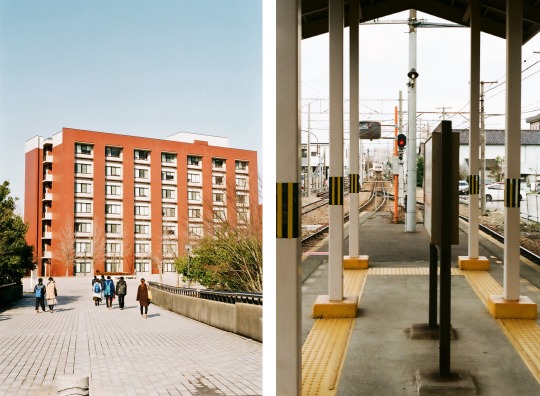
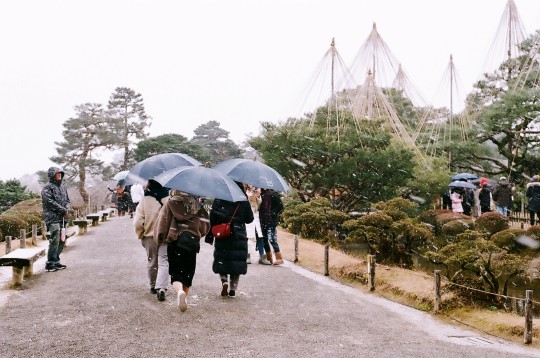
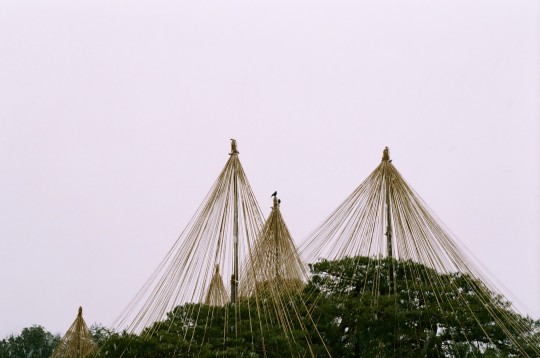
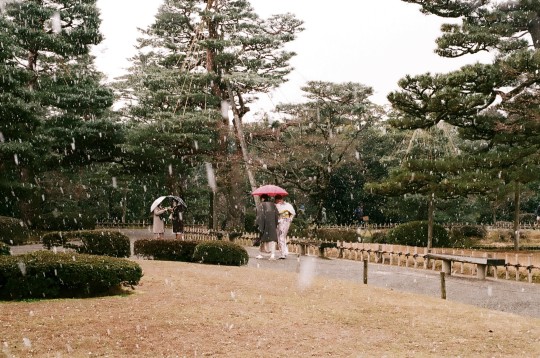
兼六園で撮ったものですね。
余談ですが,兼六園の近くに小立野という街があって,散歩したいなあと思っています。
冒頭でも触れたように,今回は格安現像サービス「超プリ!」を提供してくれるサンキューフォトさんにフィルムの現像&データ化をお願いしました。火曜日に送ったら水曜日に着いて仕上がり,金曜日(;今日)に受け取れるという快速。画像は茶色を基調としたトーンで,コダックの同プリを思い出させます。
早いし郵便振替も現金で出来るので,気軽に頼めるお店です。
それに,何と云っても安いです。カメラ屋さんで現像+データ化を頼むと1,100~1,300円はかかるのに対し,2本まとめて送ると
超プリ:726円 気軽,早い
プリネットワン:625円 綺麗!!
と,爆安。
ネットのラボは安くて良いですね!ハマりました。
そういえば今日は,
小さな女の子を連れたご夫婦とすれ違いました。お二人とも一眼を提げていて,女の子の手にも何と,「写ルンです」が ! 良いなあと思いました。無事に大きくなってくださいね。
バスに乗るとき。すぐ近くの教会から鐘が聞こえてきて,時計を見ると正午でした。良い音色!
ほんの些細なハッピーなことを大切にしまっておきます。何より,生きるための灯し火になります。
来週は木曜以外はずっと家に籠もります...。再び空虚感に襲われるのでしょうか。でも,お散歩したり映画観たり,楽しいと思うことをやって上手に気分転換したいです。絵も良いですね。
とにかく明日はレポート頑張りますね。
M Bはこれからお風呂に入って眠ります。
おやすみなさい。
2 notes
·
View notes
Photo
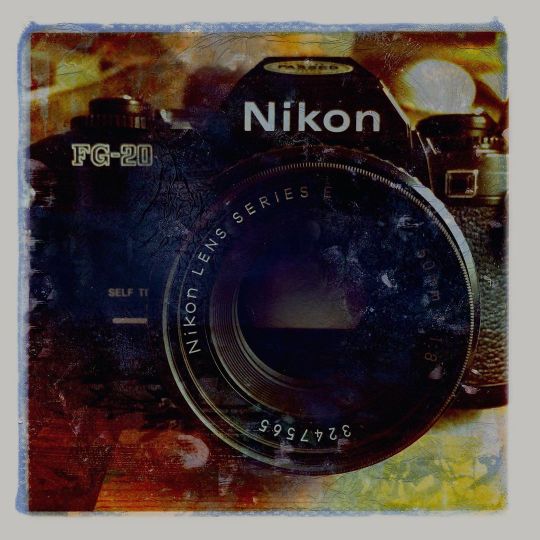
My Nikon FG-20, with a black body and Nikon Series E prime lens 50mm, 1:1.8. It has TTL centre-weighted metering, with the light metre visible through the viewfinder on the left. A hint of automatic operation (A setting aperture priority) this camera can be used completely manually and also mechanically (M90 setting) if the small batteries fail. This camera gets contemptuous treatment from most ‘professionals’ and camera buffs, but a small group of photographers love its lightweight, simply functional design (especially the black body model), as it uses any Nikon F mount lens (Ai or Ai-S). I have had mine for many years, since 1991 and it is still a fantastic camera. I sometimes wish for a Nikkor 24mm 1:2.8 wide angle lens, but the Series E 50mm 1:1.8 lens has superb optics, optical coatings to reduce flare and is compact with 52mm filter threads. I use Hoya UV(C) and a Polaroid Polarizer filters, the Hoya staying on most of the time for protection of the lens. This is one of the best Nikon cameras ever made, particularly for entry-level photography but I wouldn’t change mine for another, ‘professional’ model. It’s rare that I need a shutter speed above 1/1,000th and on A mode the shutter speeds are stepless (1/75th or 1/840th for example). . . #nikonfg20 #nikonseriese50mm #hipstamatic #frankblens #slickrock191 #shootfilm #35mmfilm #nikonuk #fg20 #photobyadrianrmarsh (at Kozyatağı) https://www.instagram.com/adrianrmarsh/p/CZL-vpYoxgW/?utm_medium=tumblr
#nikonfg20#nikonseriese50mm#hipstamatic#frankblens#slickrock191#shootfilm#35mmfilm#nikonuk#fg20#photobyadrianrmarsh
1 note
·
View note
Text
Building a Nikon Prime Lens Set for Cinematography. Part 1
This is about my attempt to put together a Nikon photo lens set for cinematography. I haven't posted to the blog in a few years and I'm not guaranteeing I'll post regularly or ever again. However, I thought I might use this space to document little things like lens tests.
While I've used many lovely cinema lens sets over the years, having a set of prime lenses of my own has always been a little out of reach financially. But I've been craving some variety after doing a lot of work on the same zoom lens. For a new creative challenge, I'm going to see if I can build a really affordable prime set around a lens I've owned since 2004. It might not work! The lenses might not match at all! Let's see.
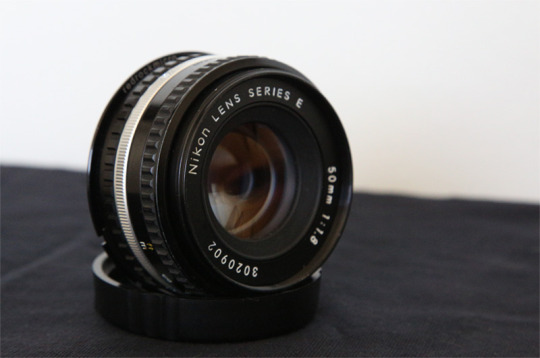
This is my Nikon Series E 50mm f1.8. The Nikon Series E lenses were designed to be more affordable and aimed at hobbyists and average consumers rather than professionals who would use the Nikkor brand lenses. They are lightweight and small due to using more plastic and fewer optical elements. When you see Nikon sets converted for cinematography, they are often AI or AI-s versions of Nikkor lenses.
I love a few things about the Nikon 50mm. After working with a somewhat clinical modern zoom lens, the visual character of the Nikon is simply refreshing. I'm not going to expand on that or give more details right now but maybe later I'll do a comparison. This lens is also very lightweight and low profile. Sometimes vintage photo lenses get rehoused into cinema housings and I totally respect the utility of that but I love having a camera build that is small, fits into tight spaces and doesn't call attention to itself. This lens also opens up to 1.8 which is quite helpful in low light or night filming.
Unlike cinema lens sets which are designed to be used together and match fairly well, photography lenses, even ones within the same brand or series can be one-off projects with different teams behind each one (Nikon has many histories of different lenses documented on their Thousand and One Nights website).
For my set, I'm going to be testing out the following Series E Nikons: the 50mm and the 100mm which are generally thought of as exceptionally good. That said, I don't even know if these two lenses will match at all. I've also thrown in a Nikkor 24mm 2.8 into the mix.
Why go Nikkor for the wide? Well the Series E only goes to 28mm and that one didn't seem to get stellar reviews. Ken Rockwell, who has generously documented countless photography lenses over the years described it as "an optically inferior 5-element 28mm f/2.8" and "crummy". Matthew Durr, who did extensive testing of Series E lenses, described the Series E 28mm as disappointing and not particularly inexpensive compared to other Series E lenses. That was enough for me to look elsewhere. I found a Nikkor 24mm 2.8 Non-AI lens for under $100 on ebay and decided to see how it looks. For reference, the 100mm series E was also just under $100 and 50mm series E lenses currently are going for $50-$80.
Test #1: What do I want to look for in these lenses? Ideally, I will set up as thorough and rigorous a lens test as Jay Holben, ASC has done and documented in American Cinematographer. For now, I want to sort out whether these lenses are even in the ballpark of each other and worth investing more time and adjustments to (like declicking the aperture ring or mounting a solid semi-permanent EF adapter and buying new rear caps). Note: I have been fond of the Red Rock micro adapters. I have one on my 50mm and for the other lenses in this test I have a Fotodiox adapter that is really sticky and makes me nervous each time I put it on a lens because it feels like it might never come off. The Red Rock adapters are around $33-35 each, and you want to buy one for each lens because mounting involves some tiny screws. Not something you'll be doing on set. Once mounted, you then need Canon EF back lens cap for each one you've adapted which are around $7 to $10 each. This semi-permanent mount change would cost about $45 for each lens but be worth it to me to speed up workflow on set and not have to bother with an anxiety-inducing removable mount.
My initial test is simple, I'm just using this color chip chart and natural, indirect window light. Confounding factors: time of day, atmospheric haze, bounce from outside of the window (foliage, buildings etc.), color of the glass in the window and screen and dust in the screen, sensor etc. A better option would be to use a full spectrum controllable light source but all I have on hand at the moment are LEDs.
First, I do a custom White balance using the 100mm lens on the Panasonic EVA1 in VLOG 150mbps / 422 UHD mode 23.98 onto the ColorChecker's whitecard.
One might expect something around 6300 for indirect light or shade.
I got 8300k -.8MG . Ok! I'm going to leave it at this setting for the all of the lenses.
I set the exposure at a 4 / 5.6 split for all of the lenses (one might also test for variations in the exposures at this point but I'm moving fast).
I'm going to bring all three clips into DaVinci Resolve and look at a few things.
1. Simple look test - I'm going to normalize the footage first by converting all of the clips from VLog to Rec 709 using tonal mapping in my project settings.
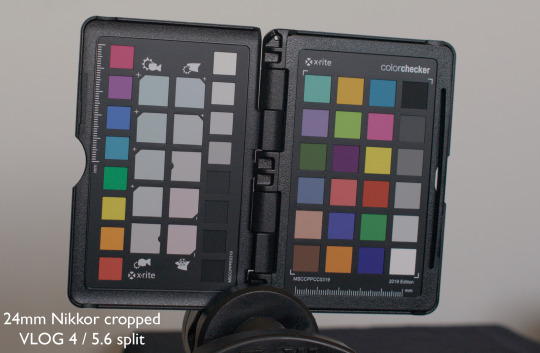
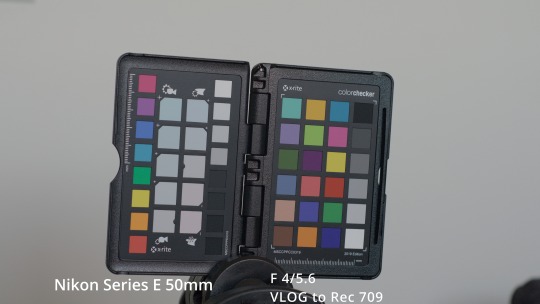
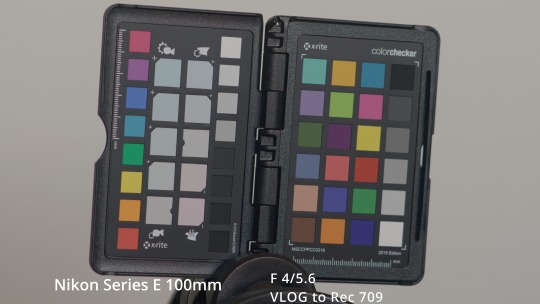
.Who knows what kinds of color transformations happened from exporting a still jpg and then uploading it here. And we also know just proximity of other colors can skew our perception which is why I cropped the 24mm for these stills.
My perception though is the 50mm looks a bit bluer just based on the wall in the background.
2. Scopes. Let's look at some scopes next using a power window to isolate the chip chart.


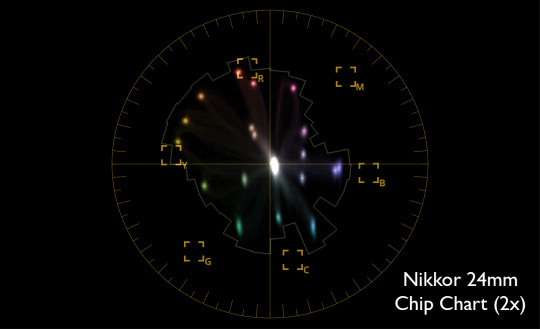
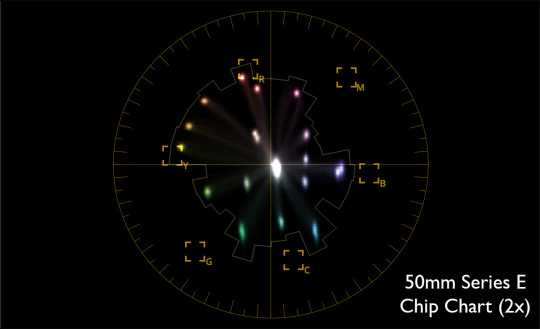
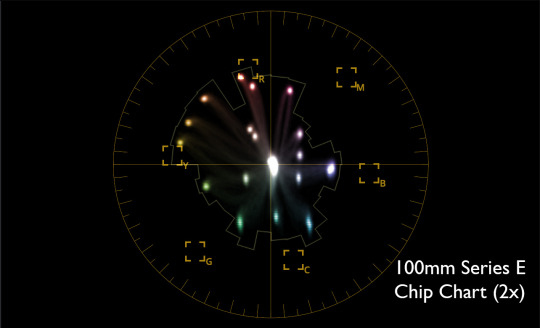
Looking at these charts and the footage, the 50mm certainly skews a bit bluer overall and none of the colors across lenses seem to exactly match up. One might have expected that the series E lenses would best match each other but the 100mm and 24mm look a bit closer to each other in my eye.
All of that said, I am encouraged to keep these lenses and continue testing for some other qualities. I don't think they are so far off from each other than modest color grading couldn't make them fairly inter-cuttable. For my next test, I'd like to keep the light source constant (even if it's an LED) and start to look at things like sharpness and contrast and the other qualities examined in Holben's test.
0 notes
Text
hello!
twitter - contact/ask page - favourite works
post directory:
events/sessions:
"somewhere around mount washington" - 9/25-9/26/21 backpacking trip to white mountain national forest. first time taking camera out
"wendy car shoot" - 10/04/21
gear:
camera body: Canon Rebel T3
lenses:
Canon EF-S 18-55mm 3.5/5.6 IS II
Canon EF 50mm f/1.8
Canon EF-S 55-250mm 4-5.6 IS II
software: Capture One 21 / Luminar AI / Photoshop
0 notes
Video
At the Louvre - 2022.06.20 by r~ Via Flickr: Nikon FM2n Nikkor 50mm f1.8 ai-s pancake Kodak Portra 400 2022079-25
#Nikon FM2n#Kodak Portra 400#Nikkor 50mm f/1.8 ai-s pancake lens#Paris#France#prime lens#Analog#Film#35mm film#C41#Color negative#flickr
0 notes
Text
Hướng dẫn mua máy ảnh mirroless và những điểm lưu ý
Có mấy điểm lưu ý khi mua chiếc máy ảnh không gương lật ( mirroless camera). Trong thực tế, người mua máy ảnh không gương lật có thể đã dùng máy ảnh DSLR mua thêm để backup, hoặc chuyển đổi sang dùng hẳn vì tính chất nhỏ gọn nhẹ nhàng linh hoạt hơn của máy không gương lật; cũng có người ban đầu sắm máy ảnh… Có vài điểm cần xác định khi chọn lựa chiếc máy phù hợp với nhu cầu thực tế của mình.
1 – Hệ thống ống kính
Thực tế: Nhiều bạn chỉ đầu tư ngân sách và thời gian sắm một thân máy (body) rất nhiều tiền, nhưng lại hài lòng với ống kính Kit đi theo máy suốt nhiều tháng năm. Dĩ nhiên là với một số nhu cầu phổ thông nhất định, ống Kit đáp ứng đủ nhu cầu, nhưng nhiều chủ đề đòi hỏi chất lượng và hiệu ứng ảnh cao hơn, thậm chí để rèn luyện kỹ năng tốt hơn, ống Kit rất giới hạn. Lý do: Các nhà nhiếp ảnh vẫn thường gọi ống kính là con mắt của chiếc máy ảnh. Các tia sáng trước khi được rọi chiếu lên kính ngắm, bề mặt tấm phim của máy chụp phim hoặc bề mặt cảm biến để tạo thành hình ảnh, thì nó phải đi qua ống kính. Lượng sáng và chất lượng các tia sáng đi qua ống kính sẽ quyết định chất lượng hình ảnh được tạo thành, hay nói cách khác chất lượng của ống kính quyết định chất lượng hình ảnh. Ống kính là yếu tố rất quan trọng, có thể nói là quan trọng nhất trong việc xử lý hình ảnh. Vì vậy: Việc lưu ý hệ thống ống kính mà hãng máy ảnh bạn chọn mua có nhiều chọn lựa hay không là điều quan trọng. Một số người mua body về rồi, loay hoay mãi không tìm mua được ống kính phù hợp nhu cầu cá nhân, nên tìm hiểu thông tin hệ ống kính xung quanh cái máy định mua trước: Về dải tiêu cự phong phú mà hệ ống kính của hãng cung cấp. Chẳng hạn hệ ống kính fixed – 1 tiêu cự – chất lượng tốt như ống góc rộng để chụp phong cảnh, chụp đường phố (28mm, 35mm, 50mm…), hoặc tele tầm trung để chụp chân dung, hoặc tele để chụp đối tượng xa. Hoặc nhu cầu ống kính zoom đa tiêu cự, hoặc ống kính đặc biệt như macro… Về hệ ống kính chính hãng lẫn ống kính hãng thứ ba sản xuất cùng ngàm. Về đa dạng chất lượng phù hợp ngân sách thấp đến cao để có chọn lựa vừa túi tiền.Và, lựa chọn ống có khẩu độ hoặc dải khẩu độ nào thì đáp ứng được cho nhu cầu chụp của mình. Chẳng hạn ống Kit có dải khẩu độ f/3.5 – f/5.6 thì khó có thể đáp ứng nhu cầu chụp chân dung “teen xoá phông”, phải kiếm ống tiêu cự từ 50mm – 135mm (FF) có khẩu độ lớn như f/1.8 – f/2.8 chẳng hạn.
Tận dụng “di sản” ống kính cũ chất lượng các hãng khác và sử dụng qua ngàm chuyển đổi. Ngàm của ống kính được hiểu tương tự như cổng kết nối giữa ống kính và máy ảnh. Mỗi hãng máy ảnh có chuẩn ngàm riêng biệt, chẳng hạn: Ngàm E cho Sony Alpha (NEX), XF cho Fujifilm, E cho Sony, 1 cho Nikon-1, EF-M cho Canon EOS M, Q cho Pentax Q, cho hệ máy ảnh 4/3 Panasonic, Olympus … Nên tự thân ống kính của hãng này không gắn được vào máy ảnh hãng khác. Những năm gần đây, nhiều người thích sử dụng các ống kính cũ xưa có ngàm không tương thích, chụp qua ngàm chuyển đổi cho các dòng máy ảnh không gương lật có thể hoán đổi ống kính, để tận dụng kho tàng ống kính cũ có chất lượng thấu kính cực tốt hoặc hệ thống lá khẩu đặc biệt để có những bức ảnh đẹp hoặc độc đáo thú vị. Nhưng, có hai điều cần biết ở điểm này là: Giá rẻ mà chất lượng & hầu hết lấy nét thủ công (MF): Ống kính cũ có ngàm chuyển đổi phổ biến nhất là loại dành cho ống kính ngàm M42, là loại ống có đuôi là ren xoáy đường kính 42mm. Dòng ống này có từ những năm đầu 1940 trên các máy Contax S, Pentax, Praktica hay Zenit cho đến những năm 1970. Khi nhiều người chơi ngàm chuyển đổi thì hệ thống ống M42 trở nên như một kho tàng vô giá và được khai thác triệt để. Ngàm chuyển đổi phổ biến thứ hai là loại dành cho ống kính AI ngàm F của Nikon. Nikon có hệ thống ống kính cũ có bề dày lịch sử với hệ thấu kính cực kỳ tốt, đa dạng tiêu cự và có những ống kính rất đặc biệt. Các dòng Nex của Sony anh em hay dùng ngàm với các ống cực kỳ chất lượng của Leica, Voigtlander, Carl Zeiss … và các ngàm chuyển hệ 4/3 khá phong phú của dòng Panasonic, Olympus…
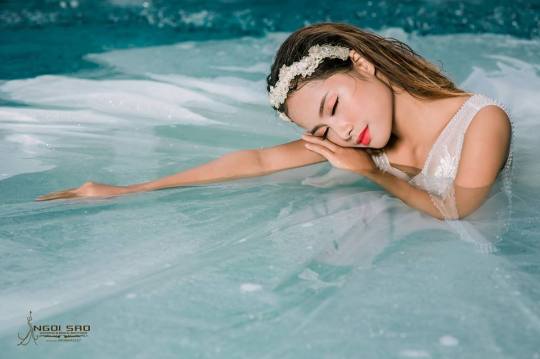
"QC" Dịch vụ quay video chuyên nghiệp, quay phim sự kiện, quay video clip, quay phim HD, tất cả các dịch vụ về quay phim…
Hotline + Viber + Zalo: 0972.123.018 (Cameraman)
Mẫu tham khảo : www.heytv.vn
Facebook : https://vi-vn.facebook.com/rophistudio/
Trang Chủ : https://seotukhoa.com.vn/
Là đơn vị cung cấp các dịch vụ quay phim tự giới thiệu doanh nghiệp, Quay video clip viral, Quay video quảng cáo – TVC, quay phóng sự… Chuyên Quay Phim Chụp Hình Full HD – Giá Cạnh Tranh – Uy Tín, Chất Lượng Cao. Cam Kết Chất Lượng Cao – Tư Vấn Hỗ Trợ 24/7. Dịch Vụ Hoàn Hảo. Đội Ngũ Kinh Nghiệm Cao. Thiết Bị Hiện Đại. Giàu Kinh Nghiệm. Ưu Đãi Tốt Về Giá.
Rô Phi Studio
“RÔ PHI STUDIO – Nhận làm clip, quay clip, Slideshow ảnh, Chụp ngoại cảnh, Quay ngoại cảnh, làm theo yêu cầu Tp.HCM. Dịch vụ làm clip sinh nhật, Clip tặng người yêu, Quay video cưới hỏi, liên hoan, hội nghị…
Dịch vụ làm video, nhận làm video quảng cáo doanh nghiệp, chụp ảnh sản phẩm, chụp anh xoay 360, dịch vụ video Tp.HCM, ảnh quảng cáo …”
Hotline ☎️: 0972.123.018 – 0931.436.637
Dịch Vụ Sản Xuất, Quay Video, Phim & Hội Nghị, Chụp Ảnh HD
Dịch vụ quay phim quảng cáo spa, tmv, giới thiệu công ty, phóng sự… 0972 123 018 Dịch Vụ Quay Phim, Quay Video Clip, MV, Làm Viral Cho Nhãn Hàng Độc Đáo Sáng Tạo. Đảm Bảo Uy Tín Chất Lượng. Đội Ngũ Chuyên Nghiệp. Thiết Bị Quay Hiện Đại. Cam Kết Giá Trị Cho KH./…
– DỊCH VỤ QUAY PHIM CHUYÊN NGHIỆP TẠI TP.HCM
– DỊCH VỤ QUAY PHIM SỰ KIỆN
– DỊCH VỤ QUAY PHIM HỘI NGHỊ, HỘI THẢO
– DỊCH VỤ QUAY PHIM VIRAL VIDEO
– DỊCH VỤ QUAY PHIM REVIEW SẢN PHẨM
– DỊCH VỤ QUAY PHIM CƯỚI HỎI
– DỊCH VỤ QUAY PHIM SINH NHẬT
– DỊCH VỤ QUAY PHIM BÀI GIẢNG
– DỊCH VỤ QUAY PHIM TEAM BUILDING
– DỊCH VỤ QUAY PHIM GIỚI THIỆU DOANH NGHIỆP
– DỊCH VỤ QUAY PHIM CA NHẠC
Hotline: 0972.123.018 Cameraman
Website: RO PHI STUDIO & VIDEO Review – Viral – Animation 2D 3D
https://vi-vn.facebook.com/rophistudio/
1 note
·
View note
Photo
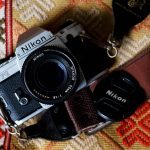
5 Frames… Of a night out in Trastevere on Kodak T-MAX 400 pushed to 3200 (35mm format / EI 3200 / Nikon FG + Nikkor 50mm f/1.8 AI-S “Pancake”) – by Max J. Raulff The following five frames were taken on a typical summer night in Rome, in early June 2019, where I had moved to in the spring to spend a semester abroad and work in the Italian galleries.
0 notes
Photo
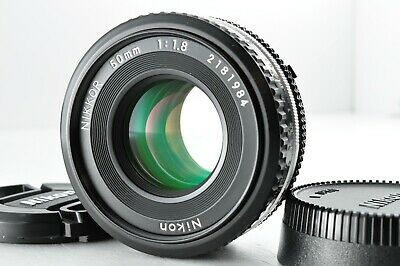
%^ [Mint] Nikon NIKKOR 50mm f/1.8 Ai-S AIS MF Standard Lens ship by DHL from Japan https://ift.tt/2CzDKul
0 notes
Photo
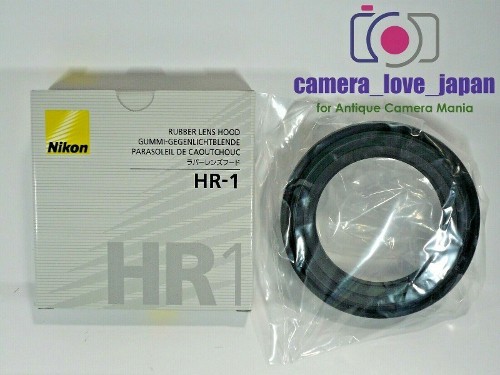
$4.99 Only! ~ {BRAND NEW} Nikon HR-1 Rubber Lens Hood for Ai-S Ai 50mm f/1.4S f/1.8S JAPAN #1, Camera Lens Hoods, Rubber Lens Hoods BUY HERE! #CameraLensHoods, #RubberLensHoods,
0 notes
Text
Come spiegare stabilizzatori ai tuoi nonni
Ogni cosa su Studio Professionale
La Canon e la Nikon sono sempre spalla a spalla, nonostante l'ingresso a testa alta della Sony, sono sempre tra le macchine fotografiche più vendute. I modelli "Entry-level" sono tra i più venduti, ma ci sono grosse sorprese, sopratutto in casa Canon, riguardo le "Specialist" La reflex più venduta è la Canon 1300D, seguita subito dopo dalla grande Nikon D 3300. La guerra tra Canon e Nikon questa volta sembra vincerla Canon con la sua ottima macchina fotografica 1300D che sta riscuotendo davvero un successo clamoroso.
L'obiettivo più venduto è il 10-18 EF-S, un obiettivo grandangolare per poter fotografare paesaggi senza perdersi nessun dettaglio. Al secondo posto il grande 55-250mm, l'esatto contrario Canon Obiettivo Ultragrandangolare con Zoom, EF-S 10-18 mm f/4.5 -5.6 IS STM Teleobiettivo Canon Compatto, EF-S 55-250 mm F/4 -5.6 IS STM Canon EF-S 55-250mm f/4 -5.6 IS II Teleobiettivo con Zoom Obiettivo Canon EF-S 2428STM Obiettivo Pancake 24 mm F/2.8 Canon Teleobiettivo, EF 50 mm f/1.8 STM SLR Teleobiettivo Canon Zoom, EF 75-300 mm f/4 -5.6 III Canon EF 50mm/1:1,8 Obiettivo Canon EF 50mm f/1.4 USM Canon Obiettivo Zoom Universale, EF-S 18-55 mm 1:3.5 -5.6 IS, 58 mm Obiettivo Canon, EF 40 mm f 2.8 STM, Versione Standard La classifica degli obiettivi Nikon più venduti.
Si può davvero fare con: Studio Professionale?
Sony Alpha 6000L Fotocamera Digitale Compatta, Obiettivo Intercambiabile, Sensore APS-C CMOS Exmor HD da 24.3 MP, Obiettivo da 16-50 mm Panasonic Lumix DMC GH 4MEG-K Fotocamera Mirrorless con Obiettivo LUMIX G VARIO, Zoom 12-60 mm/ F 3.5-5.6, 16 Megapixel Sony Alpha 6500 Fotocamera Digitale Compatta con Obiettivo Intercambiabile, Sensore APS-C CMOS Exmor da 24,2 Megapixel Canon EOS M 10 Kit Fotocamera Mirrorless con Obiettivo, EF-M 15-45 mm, 18 Mp Sony Alpha 6000 Fotocamera Digitale Compatta, Obiettivo Intercambiabile, Sensore APS-C CMOS Exmor HD da 24.3 MP Canon EOS M 10 Set Fotocamera Mirrorless con Obiettivo EF-M 15-45 mm, 18 Megapixel Alpha Sony 6300L Fotocamera Digitale Compatta con Obiettivo Intercambiabile, Sensore APS-C CMOS Exmor da 24,2 Megapixel, Obiettivo 16-50mm Sony Alpha 5000L Fotocamera Digitale Compatta con Obiettivo Intercambiabile, Sensore APS-C, CMOS Exmor HD, 20,1 MP, Obiettivo da 16-50 mm Incluso Alpha Sony 6000L Fotocamera Digitale Compatta, Obiettivo Intercambiabile, Sensore APS-C CMOS Exmor HD da 24.3 MP, Obiettivo da 16-50 mm Canon EOS M 10 Fotocamera Mirrorless, 18 Megapixel La classifica dei libri di fotografia più venduti su Amazon.
Tutti i segreti spiegati passo passo per ottenere foto da professionisti. L'occhio del fotografo. La composizione nella fotografia digitale Imparo a fotografare. Composizione, esposizione, luce, lenti, sguardo. Con gli occhi dei grandi maestri Fotografia creativa. Corso con esercizi per svegliare l'artista che dorme dentro di te La mente del fotografo Dalla mia Terra alla Terra L'occhio del fotografo.
7 Semplici Storie Dimostrate su Stabilizzatori
Sensore da 18 megapixel che permette di ottenere ottime foto, quest'ultime possono essere scattate anche in condizioni di bassa luminosità grazie all'ampia gamma di sensibilità ISO 100-6400. Possibilità di creare ritratti sfocando leggermente lo sfondo per creare ottime foto. La fotocamera presenta anche funzionalità come NFC e Wi-Fi per collegarsi agli smart device Android e i OS.
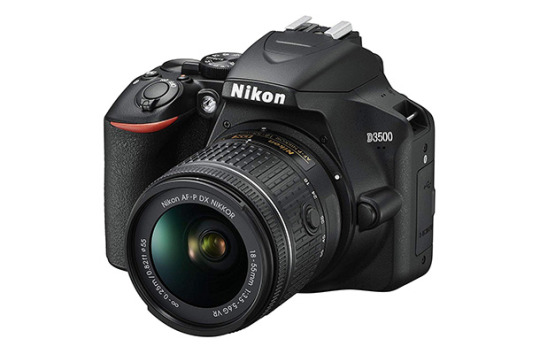
La Migliore Strategia Da Usare Per Studio Professionale
Ottimo https://beeo.it il display da 3 pollici i grado di visualizzare le immagini appena scattate. La nuova EOS 4000D è perfetta per i principianti senza però rinunciare a caratteristiche importanti. Sensore APS-C da 18 megapixel perfetto per scattare immagini splendide con sfondo naturale sfocato in tutta semplicità, anche in condizioni di scarsa illuminazione.
youtube
Fascino In Merito a Fotocamere
Il processore della EOS 4000D è il DIGIC 4+ che promette ottime prestazioni, unito alla messa a fuoco automatica cattura sempre il momento esatto. Grazie a questa reflex potrete catturare ogni dettagli grazie alla risoluzione da 24,2 megapixel del sensore APS-C di nuova generazione. Video in FULLHD con tecnologia Hybrid AF che consente la messa a fuoco continua durante le riprese video.
Schermo da 3 pollici. Per quanto riguarda le foto in condizioni di scarsa illuminazione la EOS 700D offre una sensibilità ISO 100-12800 (espandibile fino a ISO 25600). La fotocamera presenta anche funzionalità come NFC e Wi-Fi per collegarsi agli mobile phone Android e i OS EOS 80D è perfetta per la fotografia sportiva, di ritratti, paesaggistica, urbana e di viaggio.
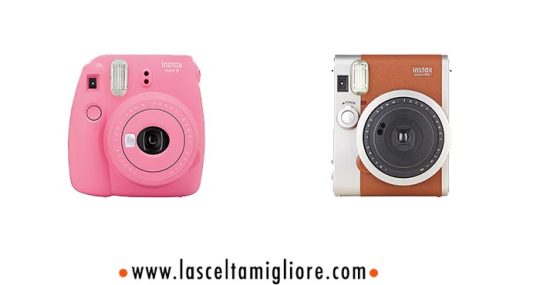
Le notizie Sconosciute Su Cavalletti
4 tecniche semplici per Accessori Fotografia
La velocità massima di scatto continuo è pari a 7 fps, il sensore montato è CMOS APS-C da 24,2 megapixelcoadiuvato da un processore DIGIC 6. Presente un esposimetro RGB+ IR da 7.560 pixel in grado di rilevare sia gli infrarossi che la luce visibile. Per quanto riguarda gli scatti in notturna la fotocamera presenta un'ampia gamma di sensibilità ISO da 100 a 16.000 (H:25.600).
0 notes
Photo
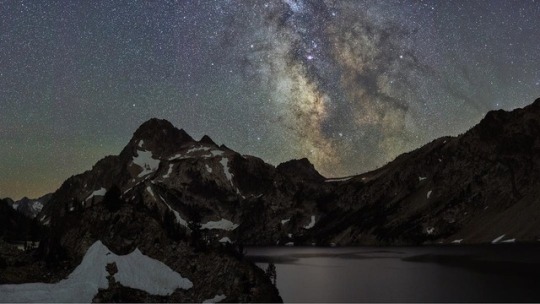
Matthew Saville Baldon at Sawtooth Lake — REPOST: @matthesavillephoto from http://ift.tt/1WIhwba chosen by @cphilpottcraig — MWC Admin: @tracyleephotos --- #milkywaychasers to be featured or post on http://ift.tt/1WIhwba. Tag a friend who might enjoy this Milky Way image and journey! --- From Matthew about this image: --- STACK, BLEND, PANORAMA ________ SOCIAL: http://ift.tt/2jHynxO http://ift.tt/2qALaD6 ________ STORY: After a serious dry period that lasted over THREE YEARS, (and, the very few adventures I did manage to go on seemed to involve way too much "getting by with crappy gear" ) ...I was finally able to get out into the wilderness, on a moonless night, with a decent camera and lens, and just enjoy the beauty of the outdoors. On the evening after the solar eclipse back in August, my friends and I (including @tracyleephotos) planned to stay another night at our eclipse viewing location, Sawtooth Lake in Idaho. The night before the eclipse had been a little bit cloudy, and while the timelapse I made turned out alright, it wasn't really optimal for shooting stills. This night, however, we were lucky enough to have clear skies all night, and even a little airglow show later in the night! I'll post that timelapse video later. This image is a combination of four stacked images at 8 sec for the sky, four stacked images at 30 sec for the foreground, ...and then repeated all over again four more times, to create a final panorama. So, 32 images in total. _____ EXIF: Nikon D800, Nikon 50mm f/1.8 AI-S (manual focus) f/2.8, ISO 6400, and 8 sec / 30 sec. --- http://ift.tt/2fonn84
1 note
·
View note
